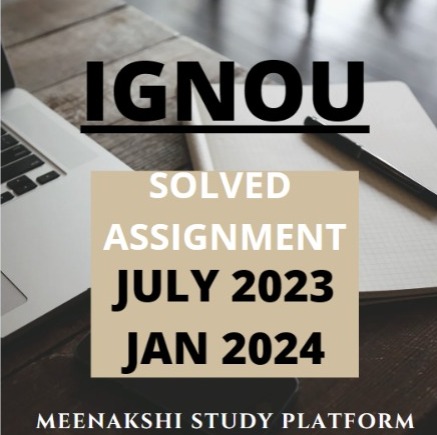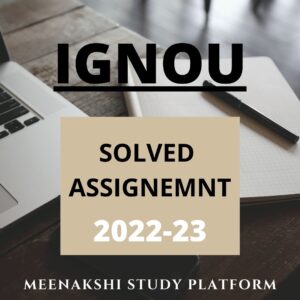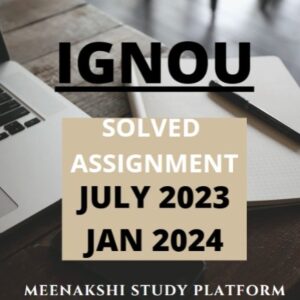Description
BEGE-145
ASSIGNMENT: SOFT SKILLS
Programme: BAG/2023-2024
Course Code: BEGE-145
Attempt all questions. All questions carry equal marks.
Total Marks: 100
Q1 Read the following passage carefully and answer the questions given below it.
The modern workplace is a diverse and dynamic environment that thrives on the contributions of individuals
from various backgrounds. However, one aspect of diversity that has gained increasing attention is disability.
Disabilities encompass a wide range of conditions, both visible and invisible, that can impact an individual’s
mobility, sensory perception, cognitive functions, and more. In recent years, there has been a growing
awareness of the need to create inclusive and accommodating workplaces that embrace employees with
disabilities.
Creating an inclusive workplace involves more than just meeting legal requirements; it requires a shift in
mindset and organizational culture. Employers are increasingly recognizing that individuals with disabilities
bring unique perspectives, talents, and strengths to the table. These individuals often demonstrate remarkable
resilience, adaptability, and problem-solving skills, qualities that can benefit teams and companies as a whole.
Reasonable accommodations play a pivotal role in enabling employees with disabilities to perform at their
best. These accommodations can range from physical modifications to the workspace, such as ramps or
accessible technology, to flexible work arrangements that are empathetic to an employee’s needs. By
providing these accommodations, employers not only empower individuals with disabilities to contribute
effectively but also demonstrate a commitment to fostering an environment of equality and respect.
However, challenges remain. Stigma and misconceptions surrounding disabilities can persist, leading to biases
and exclusion. Awareness campaigns and training initiatives can help dismantle these barriers and promote a
more empathetic and informed work environment. Additionally, ensuring that hiring processes and career
advancement opportunities are inclusive can further encourage the integration of individuals with disabilities
into the workforce.
Ultimately, an inclusive workplace benefits everyone. It promotes a sense of belonging and community among
employees, leading to higher job satisfaction and retention rates. Moreover, when companies value diversity
in all its forms, they often experience improved creativity, innovation, and problem-solving, as different
perspectives and experiences converge to drive progress.
In conclusion, disability in the workplace is a multifaceted topic that demands attention and action. By
fostering an inclusive culture, providing reasonable accommodations, and challenging stereotypes, employers
can create environments where individuals with disabilities can thrive and contribute meaningfully. Embracing
disability in the workplace is not just a legal or moral obligation; it is an investment in a richer, more diverse,
and ultimately more successful working environment.
Q1 a) Answer the following questions (5 x 2 = 10)
i. What is the significance of creating an inclusive workplace environment?
ii. How can reasonable accommodations positively impact employees with disabilities?
iii. What role do awareness campaigns and training initiatives play in addressing challenges
related to disabilities in the workplace?
iv. How does an inclusive workplace benefit both employees and companies?
v. What are some potential challenges individuals with disabilities might face in the workplace?
Q1 b) Pick out words from the passage which mean the same as the following: (5 x 1 = 5)
i. A variety of different people, ideas, and characteristics (para 1)
ii. The ability to understand and share the feelings and perspectives of others (para 3)
iii. To give someone the tools, authority, or confidence to take control of their situation and make
decisions (para 3)
iv. Preferences for or against individuals or groups, often without conscious awareness (para 4)
v. Negative perceptions or stereotypes that lead to discrimination or exclusion (para 4)
Q1 c) What have you learnt in the passage above about creating a disability-inclusive workplace? (5)
Q2 Write short notes on any two of the following: (2 x 10 =20)
i. What are blind spots in personality? Give examples.
ii. What are some steps to improve people management skills?
iii. How do biases affect teamwork?
iv. What are some factors that influence a personality?
Q3 a) Here are the answers to some questions. What are the questions? (5 x 1 =5)
i. Where ____________________?
I went to a school in Delhi.
ii. Which college or university ____________________?
I attended IGNOU for my higher studies.
iii. What ____________________?
My field of study was English language.
iv. Have you ____________________?
Yes, I completed an online course on English grammar.
v. Have you ____________________?
Yes, I have considered pursuing higher studies in English language.
Q3 b) Complete the following passage with either the present perfect or past simple tense of the verbs in
brackets (10)
In the diverse and culturally rich land of India, English occupies a unique position as a foreign language.
It (1) _____ (serve) as a bridge connecting the nation’s linguistic diversity and providing access to global
opportunities. India’s historical connection with English (2) _____ (date) back to the colonial era when it
(3) _____ (introduce) by the British. Over time, English (4) _____ (evolve) into an integral part of the
country’s education system, professional landscape, and communication networks.
India’s linguistic landscape is astonishingly varied, encompassing hundreds of languages and dialects.
This linguistic diversity can sometimes act as a barrier to effective communication between different
regions. English, with its status as a second language, (5) _____ (provide) a common ground for Indians
from various linguistic backgrounds to interact, share ideas, and collaborate seamlessly. It (6) _____
(act) as a lingua franca, enabling individuals to overcome linguistic barriers and (7) _____ (engage) in
both national and international discourse.
The Indian education system (8) _____ (embrace) English as a vital tool for academic and professional
advancement. Many private schools and prestigious institutions (9) _____ (conduct) their classes in
English, considering it a language of upward mobility. Proficiency in English (10) _____ (open) doors to
higher education opportunities abroad and enhances employability in various sectors such as IT,
business, medicine, and academia.
Q3 c) Complete these sentences with the correct comparative or superlative form of the adjectives in brackets
(5 x 1=5)
i. The internet is the _____ (fast) mode of communication.
ii. Social media is the _____ (late) fashion amongst teenagers.
iii. The large number of people make social media the _____ (rich) source of creativity.
iv. With billions of users, it is _____ (extensive) network in existence.
v. Constant innovations make the internet ____ (dynamic).
Q4 Write a report of an event in your institution. Describe the following details: (20)
i. The event timeline
ii. Major activities organised
iii. Response of the public
iv. Your contribution to the event
Q5 Write a dialogue between two friends talking about adjusting to an academic life post-pandemic. (20)







Reviews
There are no reviews yet.